Key takeaways:
- FinTech products are highly regulated and require technologies that meet strict security, performance, and scalability requirements.
- Python is one of the best programming languages for building FinTech products due to its flexibility and scalability.
- Python has a wide range of ready-to-use tools and libraries that cover all FinTech tasks, from secure transactions to algorithmic trading.
- Financial companies may require expert assistance with securing sensitive personal and financial data through encryption, regular vulnerability checks, and strong authentication.
FinTech products are complex and challenging to build: they are highly regulated and have to provide excellent service while being constantly at risk of hacking attacks.
Products of such complexity demand high performance, flexibility, security, and scalability. The technology stack should reflect these needs. At the same time, it should be easy and convenient to work with so that companies can quickly react to changes in financial market demands and trends.
You can meet all these requirements with Python, a high-level multipurpose programming language that comes with thousands of native and third-party libraries. In this article, we discuss how Python is used in financial software development and share insights on how your FinTech project may benefit from it.
You will learn how Python can help you tackle core FinTech tasks and what libraries and frameworks you can use for specific cases. You will also discover four major aspects to take into account when you choose Python for building a FinTech solution.
This article will be useful for project and development leaders who are planning a FinTech project and are looking for expertise in choosing the technology stack and developing the software.
Contents:
Advantages of Python in FinTech
Is Python good for finance? In short, yes.
Python is widely used in technology stacks of finance products. Let’s look at the most meaningful reasons to use Python in FinTech software:
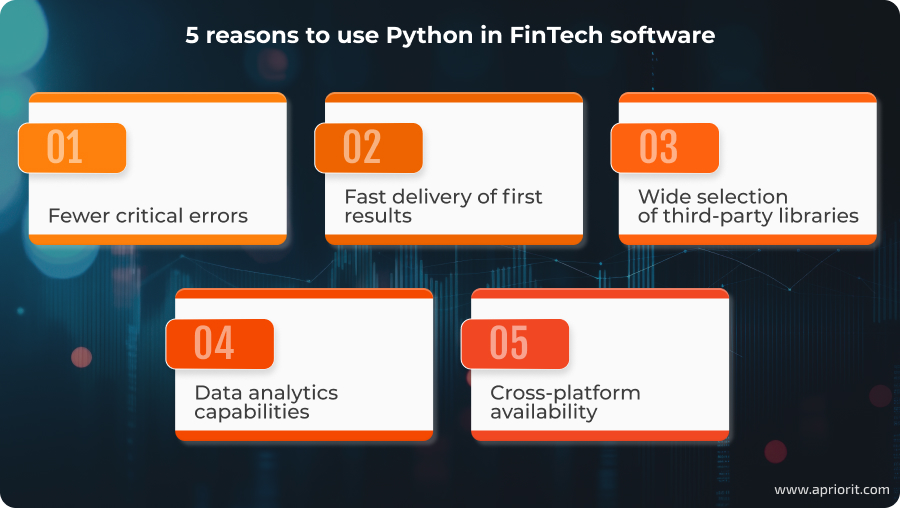
1. Fewer critical errors
With the financial industry being one of the most heavily regulated, delivering a quality and scalable solution is crucial. In particular, the industry dictates strict requirements for how user and application data should be handled.
With Python, you can significantly reduce the rate of critical errors in your solution thanks to the language’s simple syntax, which resembles plain English. This enables developers to quickly detect potential errors during code reviews — if not avoid making critical errors in the first place. Along with coding guidelines like PEP 8, Python offers a wide selection of standard and third-party code review tools meant to help developers check the readability and maintainability of their code as well as to detect bugs and high-risk vulnerabilities.
2. Fast delivery of first results
Python enables a significant increase in development speed, allowing your development team to reduce the overall time to market for your software.
Python works well for quickly building prototypes and minimum viable products (MVPs). Starting with a basic functionality set, you can evaluate your business idea, check how customers respond to your offer, and find investors for your Python FinTech project.
This language also provides the flexibility needed for timely adjustments, which is critical for FinTech solutions. Thanks to Python’s performant code, you can easily change existing functionality and add new features to your software while maintaining the required level of performance and security.
3. Wide selection of third-party libraries
With hundreds of thousands of libraries and packages to choose from, Python offers a rich selection of solutions for building quality FinTech products. Most of the tools and libraries are open-source.
You can easily find a library for running complex calculations, incorporating machine learning models, making data-driven predictions, or integrating your product with a third-party service. In the following two sections, you can learn about some of the most popular Python libraries and packages and the tasks you can use them for.
4. Data analytics capabilities
Another reason to choose Python for FinTech solutions is that this language works great for all sorts of mathematical tasks and allows for smooth integration with data science tools. Using this language, you can easily create formulas and algorithms for performing sophisticated financial calculations.
Python also supports integration with MATLAB, which is a platform commonly used by financial professionals.
5. Cross-platform availability
Last but not least, when using Python for FinTech enterprise solutions, you can easily make your product available across multiple platforms. Delivering cross-platform software is a sure way to reach a broader audience, attract new customers, and improve the user experience for existing ones.
Using Python for finance applications, you can build a product that supports the following platforms:
- Windows
- Linux
- macOS
- Android
- iOS
You can also use Python to program single-board computers like Raspberry Pi.
Ready to build an outstanding FinTech app?
Reach out to us now for expert assistance in Python development and drive the flexibility, performance, and security of your solution.
Where is Python used in FinTech?
From basic transactions to complex diagrams, Python has a tool for every trick.
There are multiple ways you can use Python in the banking industry, from traditional banking software to cryptocurrency exchange platforms. The main FinTech tasks that can be tackled with the help of Python include:
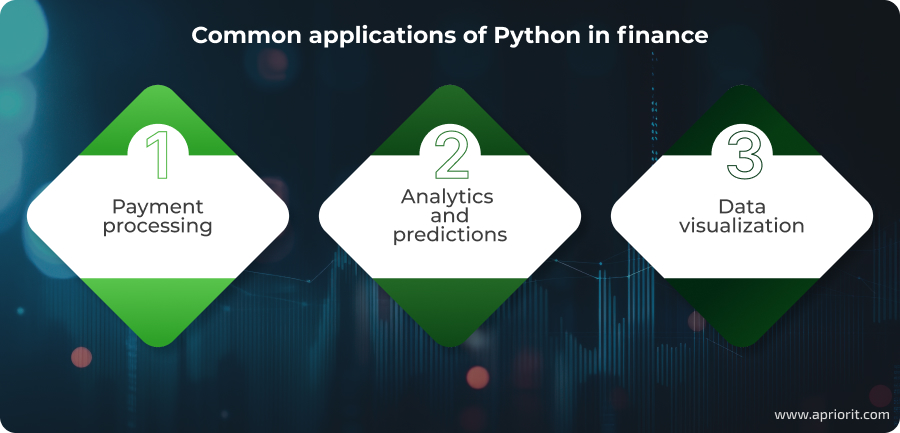
Let’s look at each of these applications.
1. Payment processing
Payment solutions are one of the most common use cases for Python in finance. This language offers secure APIs, great scalability, and smooth payment gateway integration — all crucial for delivering a competitive FinTech solution.
Organizations operating in the financial industry use Python to build ATM software, digital wallets, transaction management platforms, and cryptocurrency solutions.
2. Analytics and predictions
Trading organizations, banking institutions, and digital markets all need to process and analyze large volumes of financial data. FinTech players use Python to build solutions for developing stock trading strategies, predicting changes in cryptocurrency prices, approving loans, and so on.
Using dedicated Python libraries, you can deliver an application that analyzes large datasets, detects patterns in and extracts valuable insights from processed data, and helps you predict possible outcomes.
3. Data visualization
Being able to process and analyze large volumes of financial data is crucial for FinTech solutions. However, to make the results of such analysis useful and actionable, financial applications require additional data visualization capabilities.
Data visualization turns the results of complex calculations into easy-to-understand charts, graphs, and diagrams. By visualizing the results of data analysis, you can make it easier for end-users to spot patterns in data, determine possible trends, and make efficient data-driven decisions.
When using Python for FinTech development, you get access to a rich selection of libraries and frameworks that can help you efficiently tackle almost any task. However, there are several significant considerations to take into account.
Top Python libraries and packages for FinTech
Python offers dozens of ready-to-use tools to build FinTech products, allowing your development team to easily integrate complex functionality without having to invent every part of it from scratch.
In this section, we give just a few examples of frameworks and libraries your team can use to build your FinTech product. Some of these tools can help you build various types of software, while others are specific to the development of financial industry products.
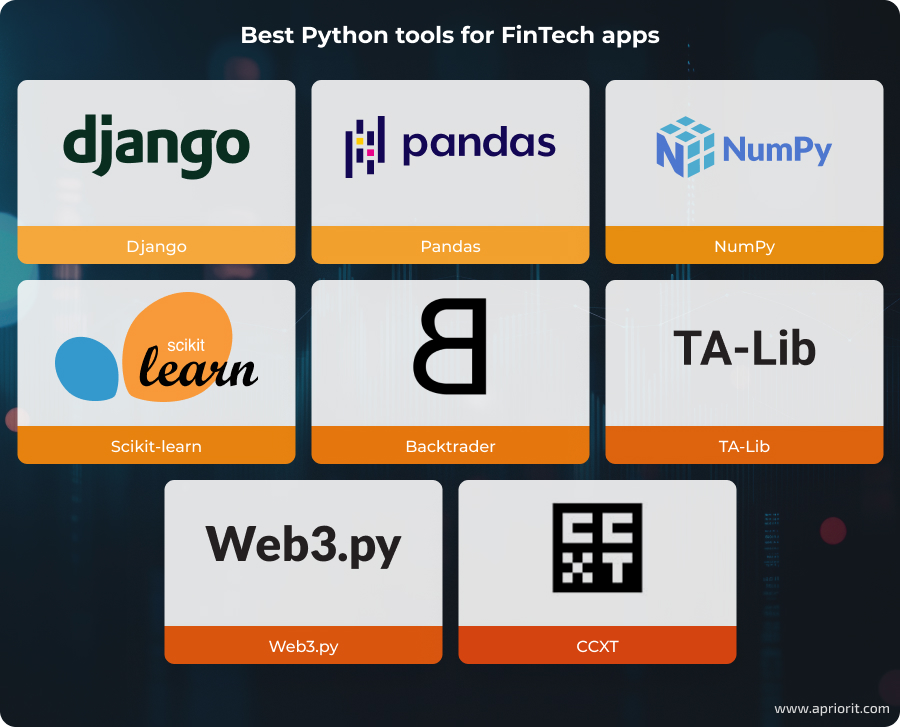
Django
Django is a high-level web framework that developers often choose to build secure and scalable products. It has built-in functionality that’s crucial for financial products, including authentication, database management, and REST API support. These features allow Django-based apps to:
- Securely handle sensitive financial transactions
- Integrate with third-party payment gateways
- Develop scalable financial platforms fast
Django’s main advantage is its wide selection of out-of-the-box tools that reduce development time and security risks.
Read also
Anomaly Detection on Social Media: How to Build an AI-Powered SaaS Platform with Python Tools
Develop a smart anomaly detection solution. Learn who can benefit from such a solution and how to use AI and Python to create a SaaS media monitoring platform for your customers.

Pandas
Pandas is a library for working with structured financial data that offers flexible data structures like DataFrames and Series. It simplifies:
- Cleaning and transforming messy financial datasets
- Performing time-series analysis for stock and crypto markets
- Merging and aggregating large volumes of transaction data
Pro tip: You can integrate Panda with NumPy and Matplotlib to get an all-in-one solution for manipulating and visualizing financial data.
NumPy
NumPy is an array processing tool that supports high-performance operations. In your FinTech application, you can apply it to:
- Building risk modeling solutions enabled by matrix computation
- Creating statistical and predictive financial models
- Optimizing large-scale trading algorithms
Apriorit developers often recommend NumPy for FinTech solutions that require processing massive financial datasets.
Scikit-learn
Scikit-learn is a machine learning library that simplifies predictive analytics in finance. You can use it to build algorithms for:
- Loan approval and credit risk models
- Detecting fraudulent transactions
- Creating data-driven investment strategies
Scikit-learn is combined with powerful built-in tools for feature selection and model evaluation.
Pro tip: Combine scikit-learn with NumPy and SciPy to optimize mathematical operations and computations, making your models faster and more efficient.
Backtrader
Backtrader is a popular backtesting framework that allows traders to test and refine investment strategies before deploying them in real markets. It supports:
- Historical market data analysis for accurate strategy validation
- Multiple broker integrations for live trading execution
- Custom indicator creation for technical analysis
You can integrate this framework into your investment or trading application to enable your users to test and optimize their trading strategies.
TA-Lib
TA-Lib (Technical Analysis Library) is another tool for algorithmic traders. In comparison to Backtrader, TA-Lib is used for advanced real-world trading. It offers over 150 indicators and functions that include:
- Moving averages (SMA, EMA), Bollinger Bands, and MACD
- Momentum and volume-based indicators for market trend analysis
- Pattern recognition for identifying buy/sell signals
The speed and efficiency of TA-Lib make it ideal for high-frequency trading systems.
Web3.py
Web3.py is a key library for interacting with Ethereum-based blockchain applications. If you plan to build a blockchain-based application, this library will allow you to:
- Write and deploy smart contracts in DeFi applications
- Manage cryptocurrency transactions programmatically
- Retrieve on-chain data for financial analytics
CCXT
CCXT (CryptoCurrency eXchange Trading Library) is an essential tool for traders managing multiple crypto exchange accounts. By integrating it into your FinTech solution, you can provide:
- Unified API access to major exchanges like Binance, Coinbase, and Kraken
- Automated execution of trading strategies across multiple platforms
- Real-time and historical market data retrieval for analysis
CCXT provides a standard interface for trading between multiple crypto platforms, making it simpler for end-users.
This is just a fraction of the Python libraries, frameworks, and tools available for your FinTech application. At Apriorit, we combine niche and well-known tools to compose the best toolkit for building FinTech products.
Let’s look at how real companies currently apply Python to their business needs.
Read also
Best Python Framework for Backend Development: Django vs. Flask vs. Tornado
Choose the best Python framework for your business needs. Read our practical guide comparing three frameworks by development speed, code maintainability, and security.

Real-world use cases of Python in FinTech
Below, we look at a few companies that are using this versatile development language to expand functionality and generate value for end-users.

Holvi: banking, invoicing, and bookkeeping
Holvi is a digital banking platform that combines banking with invoicing and bookkeeping services for small businesses and freelancers. It uses Python to automate financial management for its users.
By leveraging Python libraries like Pandas for data manipulation and Django for web applications, Holvi streamlines accounting processes, automating financial reports, invoices, and bookkeeping updates.
QuantConnect: algorithmic trading
QuantConnect is a cloud-based platform that allows developers and quantitative researchers to build, backtest, and deploy algorithmic trading strategies. Python is the primary language used on QuantConnect. It enables users to write complex strategies using libraries like Backtrader for backtesting and Scikit-learn for predictive modeling.
Revolut: real-time risk analysis in financial transactions
Revolut is a global financial super-app that offers everything from banking to investment and foreign exchange services. Revolut uses Python to detect fraudulent transactions in real time. By using Python-based machine learning models, Revolut can detect suspicious transactions based on customer behavior patterns, reducing fraudulent activity.
Coinbase: cryptocurrency transactions
Coinbase is one of the largest cryptocurrency exchanges, enabling users to buy, sell, and store digital assets. It uses Python to integrate various APIs for secure cryptocurrency transactions and to automate digital wallet management. By using Python libraries like CCXT for cryptocurrency exchange integrations and Web3.py for Ethereum-based interactions, Coinbase can seamlessly interact with multiple exchanges, execute smart contract transactions, and provide users with a secure and efficient platform for managing their digital assets.
FICO: credit risk assessment
FICO is a leading provider of analytics software for credit scoring and risk management. The company’s Python-powered machine learning models help banks and financial institutions assess the creditworthiness of borrowers by analyzing vast amounts of financial data.
Stripe: fraud prevention
Stripe is a popular payment processing platform for online businesses. Python is integral to fraud detection and risk analysis within Stripe’s payment processing services. Like Revolut, Stripe analyzes real-time transactions to spot anomalies and prevent fraudulent activities using Python-based tools and libraries like TensorFlow.
As you can see, Python offers a wide array of built-in tools that FinTech companies of all sizes use to meet their business and technical needs. However, when developing with Python, you still need to account for specific technical nuances that can make or break your app’s success.
Related project
Evaluating Smart Contract Security for Decentralized Finance (DeFi)
Explore how Apriorit performed an in-depth smart contract audit and provided recommendations on contract mitigation to ensure flawless security and help the client maintain a reputation for reliability and customer trust.
4 things to consider when building a Python FinTech solution
Finally, let’s talk about some technical aspects you should pay close attention to when working on a Python application for the FinTech domain. Depending on the tasks and purposes you have in mind for your product, the list of critical features may vary. The following four requirements, however, are common for all solutions written in Python:
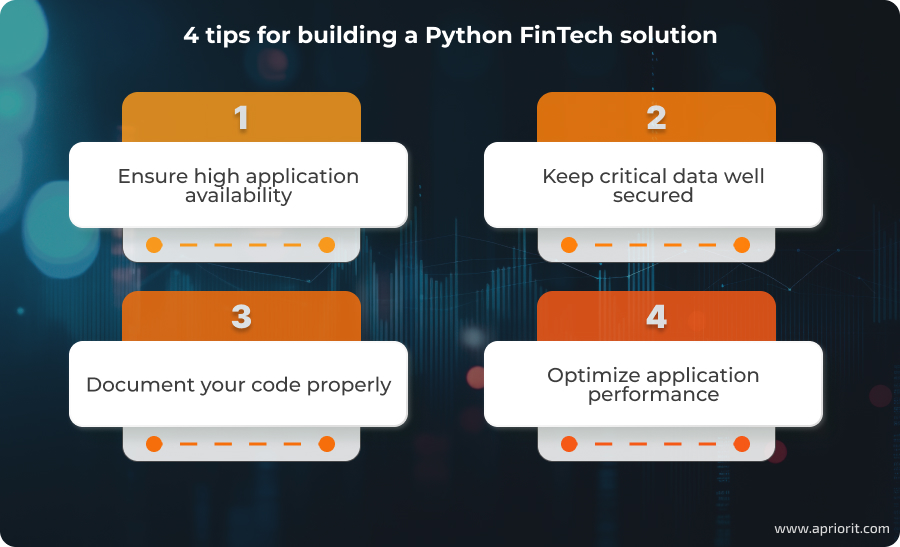
1. Ensure high application availability
Before you start building new Python software, you need to plan its deployment with high availability in mind. A modern solution is expected to effectively handle potential server failures, avoid downtime and outages, and automatically restore lost data if needed.
To make sure that your application is highly available, you can:
- Deploy the application over multiple servers
- Distribute the servers across geographical zones
- Ensure database availability with various scaling methods
2. Keep critical data well-secured
FinTech solutions continually process different kinds of sensitive data, from customers’ personal data to transaction details. Being a valuable asset for cybercriminals, such data requires enhanced protection.
Here’s what you can do to improve the security of the data processed by your FinTech software:
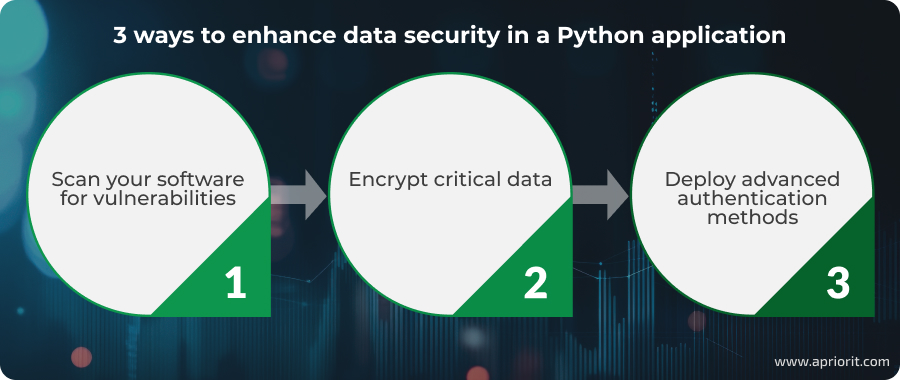
1) Scan your software for vulnerabilities
Make sure to thoroughly analyze your product for potential security breaches and vulnerabilities. Python offers a large selection of dedicated security analysis tools. You can start with commonly used static analysis tools like bandit or Dlint.
Also, make sure to sanitize external data and remove any sensitive information from external sources that your application isn’t supposed to handle. This can be done with the help of the schema and bleach libraries.
2) Encrypt critical data
Encryption is a great way of securing sensitive data from the risk of compromise. This approach enables you to ensure privacy and secure storage of business-critical data and efficiently protect such data from unauthorized access. Also, make sure to enable real-time notifications so you can start remediating detected security threats as soon as possible.
While the standard Python library doesn’t have built-in encryption functionality, you can encrypt data processed by your software with the help of external libraries such as PyCryptodome, PyNaCl, and Cryptography.
3) Deploy advanced authentication methods
Another great way to enhance data protection and reduce the risk of accidental data disclosure on the end user’s side is by deploying advanced authentication methods. In particular, you may consider adding capabilities like multi-factor authentication (MFA) and biometrics-based authentication to your FinTech application.
For implementing MFA, you can use PyOTP — a popular Python library for generating and verifying one-time passwords. For biometrics authentication, specifically for methods based on fingerprint or face recognition, you can rely on machine learning libraries like Keras and OpenCV.
Note: If poorly planned or executed, additional security measures may prevent end-users from comfortably working with your product or service. Therefore, you need to double-check how a specific security measure affects the user experience before moving forward with its implementation.
Read also
6 Emerging Cybersecurity Trends for 2025 to Futureproof Your Product
Need to protect your product? Explore the best ways to secure software against emerging threats and stay future-proof against hackers.

3. Document your code properly
Properly composed code documentation will benefit both developers and end-users working with your Python software. Documentation should be detailed and well-structured, explicitly covering what your code does and how to use it. Once you generate project documentation, you need to review and update it regularly.
Composing all documentation manually is possible, but it usually takes too much time, especially within large projects. Instead, you can turn to dedicated tools that generate documentation automatically. Commonly used tools for generating code documentation include Epydoc, Read the Docs, FastAPI, and Sphinx.
4. Optimize application performance
Flawless performance is one of the key features of successful and popular software. Performance testing is a proven way to assess the current state of your application and determine what needs to be improved. By analyzing the results of performance tests, you can evaluate:
- Stability
- Scalability
- Performance under load
- And more
It’s vital to run performance tests regularly and use their results to efficiently optimize your solution’s performance. JMeter and Locust are two common tools you can use to execute load and performance testing of a Python application.
Conclusion
Python provides businesses operating in the financial sector with an opportunity to build quality and secure products faster than with other popular programming languages. The flexibility of Python code makes it easy to change existing software features and enhance your software with new functionality so you can efficiently meet your end-users’ needs.
To leverage these benefits, your team will need deep technical expertise and experience in using Python to solve FinTech-related tasks like secure data handling and performance optimization for high-load systems. Partnering with a team that has real-world expertise in developing Python-based financial solutions ensures that your product is built to the highest standards.
At Apriorit, we have vast experience developing Python solutions for various industries, including challenging sectors like finance, blockchain, healthcare, and cybersecurity.
Looking for expert Python developers?
Let Apriorit professionals build a transparent, cohesive, and flexible financial application that meets your business needs.



